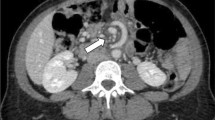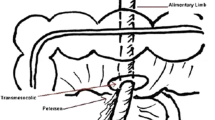Abstract
Objectives
To investigate whether compression of the superior mesenteric vein (SMV) on computed tomography (CT) can serve as a valid sign of internal herniation (IH) in patients with antecolic laparoscopic Roux-en-Y gastric bypass (LRYGBP).
Materials and methods
With institutional review board approval, we performed a retrospective analysis of 41 patients with antecolic LRYGBP referred for acute CT of the abdomen with suspicion of IH or another cause of acute abdomen. CT scans were randomly reviewed for signs of IH by two radiologists in a blinded manner, and the findings were correlated with the results of the patients’ bariatric workup. Sensitivity, specificity, and inter-observer agreement were calculated for each sign.
Results
Five patients were classified as having intermittent IH and were excluded. Eighteen patients were found to have IH at laparoscopy and served as the study group; 18 patients served as the control group. SMV compression had the best sensitivity (67 % for both reviewers) and inter-observer agreement (kappa = 0.82) of all investigated signs. The swirl sign showed a lower sensitivity (39 and 50 % respectively) and kappa (0.37).
Conclusion
SMV compression is a reliable sign of IH in patients with antecolic LRYGBP.
Key Points
• CT can help detect internal herniation after laparoscopic Roux-en-Y gastric bypass.
• Compression of the superior mesenteric vein is a sign of internal herniation.
• This sign has a high inter-observer-agreement.
• A diagnosis of internal herniation can be made with greater confidence.




Similar content being viewed by others
Abbreviations
- CT:
-
computed tomography
- IH:
-
internal herniation
- LRYGBP:
-
laparoscopic Roux-en-Y gastric bypass
- SMV:
-
superior mesenteric vein
References
Geubbels N, Lijftogt N, Fiocco M, van Leersum NJ, Wouters MWJM, de Brauw LM (2015) Meta-analysis of internal herniation after gastric bypass surgery. Br J Surg 102:451–460
Martin LC, Merkle EM, Thompson WM (2006) Review of internal hernias: radiographic and clinical findings. AJR 186:703–717
Ramos-Andrade D, Andrade L, Ruivo C, Portilha MA, Caseiro-Alves F, Curvo-Semedo L (2016) Imaging the postoperative patient: long-term complications of gastrointestinal surgery. Insights Imaging 7:7–20
Ahmed AR, Rickards G, Husain S, Johnson J, Boss T, O’Malley W (2007) Trends in internal hernia incidence after laparoscopic Roux-en-Y gastric bypass. Obes Surg 17:1563–1566
Higa K, Tienchin H, Tercero F, Yunus T, Boone KB (2011) Laparoscopic Roux-en-Y gastric bypass: 10-year follow-up. Surg Obes Relat Dis 7:516–525
Steele KE, Prokopowicz GP, Magnuson T, Lidor A, Schweitzer M (2008) Laparoscopic antecolic Roux-En-Y gastric bypass with closure of internal defects leads to fewer internal hernias than the retrocolic approach. Surg Endosc 22:2056–2061
Al Harakeh AB, Kallies KJ, Borgert AJ, Kothari SN (2016) Bowel obstruction rates in antecolic/antegastric versus retrocolic/retrogastric Roux limb gastric bypass: a meta-analysis. Surg Obes Relat Dis 12:194–198
Obeid A, McNeal S, Breland M, Stahl R, Clements RH, Grams J (2014) Internal hernia after laparoscopic Roux-en-y gastric bypass. J Gastrointest Surg 18:250–256
Higa KD, Tienchin H, Boone KB (2003) Internal hernias after laparoscopic roux-en-y gastric bypass: incidence, treatment and prevention. Obes Surg 13:350–354
O’Rourke RW (2011) Management strategies for internal hernia after gastric bypass. J Gastrointest Surg 15:1049–1054
Ekelund M (2015) Commentary on [1]. Br J Surg 102:460–461
Blachar A, Federle MP, Brancatelli G, Peterson MS, Oliver JH III, Li W (2001) Radiologist performance in the diagnosis of internal hernia by using specific CT findings with emphasis on transmesenteric hernia. Radiology 221:422–428
Lockhart ME, Tessler FN, Canon CL et al (2007) Internal hernia after gastric bypass: sensitivity and specificity of seven CT signs with surgical correlation and controls. AJR 188:745–750
Maier J, Floyd AK (2015) Redefining the mesenteric swirl sign in the diagnosis of internal herniation after Roux-en-y gastric bypass. Insights Imaging 6:S217. doi:10.1594/ecr2015/B-0258
Kristensen SD, Naver L, Jess P, Floyd AK (2014) Effect of closure of the mesenteric defect during laparoscopic gastric bypass and prevention of internal hernia. Dan Med J 61:A4854
Trajman A, Luiz RR (2008) McNemar test revisited: comparing sensitivity and specificity of diagnostic examinations. Scand J Clin Lab Invest 68:77–80
Iannuccilli JD, Grand D, Murphy BL, Evangelista P, Roye GD, Mayo-Smith W (2009) Sensitivity and specificity of eight CT signs in the preoperative diagnosis of internal mesenteric hernia following Roux-en-Y gastric bypass surgery. Clin Radiol 64:373–380
Goudsmedt F, Deylgat B, Coenegrachts K, van de Moortele K, Dillemans B (2015) Internal hernia after laparoscopic Roux-en-y gastric bypass: a correlation between radiological and operative findings. Obes Surg 25:622–627
Acknowledgments
The scientific guarantor of this publication is Jens Maier. The authors of this manuscript declare no relationships with any companies, whose products or services may be related to the subject matter of the article. The authors state that this work has not received any funding. One of the authors has significant statistical expertise. No complex statistical methods were necessary for this paper. Institutional Review Board approval was obtained. Written informed consent was not required for this study because it was retrospective. Methodology: retrospective, case-control study/diagnostic or prognostic study/observational, performed at one institution.
Author information
Authors and Affiliations
Corresponding author
Rights and permissions
About this article
Cite this article
Maier, J., Herrasti Gallego, A. & Floyd, A.K. Compression of the superior mesenteric vein—a sign of acute internal herniation in patients with antecolic laparoscopic Roux-en-Y gastric bypass. Eur Radiol 27, 1733–1739 (2017). https://doi.org/10.1007/s00330-016-4526-9
Received:
Revised:
Accepted:
Published:
Issue Date:
DOI: https://doi.org/10.1007/s00330-016-4526-9




